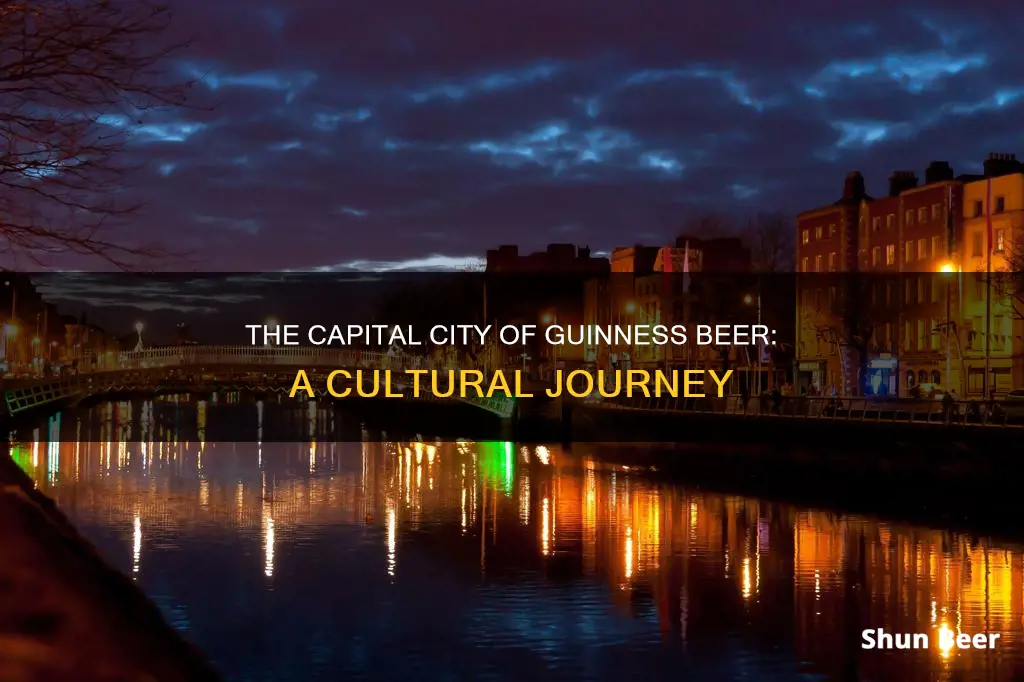
Dublin is the capital city of Ireland and the birthplace of Guinness beer. The St. James's Gate Brewery was founded in 1759 by Arthur Guinness, who leased the site for 9,000 years at £45 per year. The first Guinness beer was brewed in Leixlip, County Kildare, and then from 1759 at the St. James's Gate Brewery in Dublin. The company is now a part of Diageo, formed from the merger of Guinness and Grand Metropolitan in 1997. The main product of the brewery is Draught Guinness, a dry stout that is one of the most successful beer brands worldwide.
| Characteristics | Values |
|---|---|
| Origin | Dublin, Ireland |
| Founder | Arthur Guinness |
| Year founded | 1759 |
| Brewery location | St. James's Gate, Dublin |
| Annual rent | £45 |
| Lease duration | 9,000 years |
| Current owner | Diageo |
| Main product | Draught Guinness |
| Tourist attraction | Guinness Storehouse |
What You'll Learn

The history of Guinness beer
Guinness became Ireland's largest brewery in 1838 and continued to expand its reach, exporting its beer to England and other parts of the world, including Lisbon, South Carolina, New York, Barbados, and Sierra Leone by 1820. The business was passed down to Arthur Guinness II, who maintained and grew the brewing operation, making the St. James's Gate Brewery the largest in Ireland.
In the 1850s, Arthur Guinness II's son, Benjamin Lee Guinness, took over the business. In the 1860s, he created the first trademark label for Guinness stout, featuring a harp design and the word "GUINNESS," which is still used today. Benjamin Lee Guinness also contributed to the restoration of St. Patrick's Cathedral in Dublin and donated St. Stephen's Green, a private green, to the city for everyone to enjoy.
The Guinness business continued to be passed down through the family, with Edward Cecil Guinness taking over after Benjamin's death. Edward focused on enhancing the welfare of the Brewery's workforce and established a laboratory in 1901 to improve the brewing process through scientific approaches.
Guinness became the world's largest brewer of stout in 1886, producing 1.2 million barrels annually. The company continued to innovate and expand, and in 1959, it introduced nitrogen to its beers, creating the distinctive creaminess associated with Guinness.
Today, Guinness is owned by Diageo, a British multinational beverage company, and it remains one of the most successful alcohol brands worldwide, brewed in almost 50 countries and available in over 120. The Guinness Storehouse in Dublin, a converted brewing facility and museum, is a popular tourist attraction, showcasing the brand's history, brewing techniques, and celebrated advertising campaigns.
Guinness Beer Alternatives: Exploring Dark and Delicious Brews
You may want to see also

Guinness Storehouse
The Guinness Storehouse is a tourist attraction at St. James's Gate Brewery in Dublin, Ireland. It has been open since 2000 and has received over 20 million visitors. The Storehouse covers seven floors surrounding a glass atrium shaped like a giant pint of Guinness. The building was constructed in 1902 as a fermentation plant for the St. James's Gate Brewery and was the first multi-storey steel-framed building in Ireland.
The ground floor introduces visitors to the beer's four ingredients (water, barley, hops, and yeast) and the brewery's founder, Arthur Guinness. The 9,000-year lease signed and sealed in 1759 by Arthur Guinness himself is on display at the bottom of the atrium. Other floors feature the history of Guinness advertising, including iconic advertisements that have become pillars of Irish culture worldwide, and an interactive exhibit on responsible drinking.
The seventh floor houses the Gravity Bar, which offers unparalleled 360-degree views of Dublin. Visitors can enjoy a complimentary pint of Guinness included in the price of admission while taking in the stunning views. The Storehouse also offers various experiences, such as learning how to pour the perfect pint of Guinness or printing your selfie on the head of a creamy pint.
In addition to the interactive and educational exhibits, the Guinness Storehouse provides exceptional restaurant experiences. The Brewery Bar on the fifth floor offers Irish cuisine, incorporating Guinness in both the cooking and as an accompaniment to the food. The 1837 Bar & Brasserie, named after the year Guinness and oysters were declared a perfect match, serves delicious classics with curated beer pairings. Arthur's Bar, a contemporary space with views across the city, offers dishes such as Guinness & Herb sausages and mash, tasty burgers, and steak sandwiches, all paired with the perfect beers.
Guinness Beer: Dairy-Free Delight or Dairy Disaster?
You may want to see also

Guinness and the harp symbol
The harp is a symbol with a long history in Ireland, dating back to at least the 8th century when it can be seen on manuscripts and Christian stone crosses. The harp has been a symbol of Ireland since the 13th century, and it was made the official emblem of Ireland by Henry VIII in 1541.
In 1862, Guinness adopted the O'Neill harp, also known as the Brian Boru harp, as the emblem on its Guinness glasses and bottle labels. The harp is based on a famous 14th-century Irish harp, which is now preserved in the Library of Trinity College Dublin. The harp was chosen as a symbol of Guinness in 1862 and was registered as a trademark in 1876. The harp is one of three elements that make up the Guinness brand livery, along with the word "Guinness" and Arthur Guinness's signature.
The use of the harp symbol by Guinness caused an issue for the new Irish Free State Government in 1922, which wanted to use the harp as the official symbol of Ireland. As Guinness had already trademarked the symbol, the government was forced to reverse the direction of the harp in its emblem to differentiate it from the Guinness harp. The Guinness harp always appears with its straight edge to the left, while the government harp has its straight edge to the right.
The harp continues to be a symbol of both Guinness and Ireland, with the harp appearing on government documents, coins, and passports, as well as Guinness products.
Guinness vs Beer: Which Brew Packs a Harder Punch?
You may want to see also

Guinness advertising
Guinness has a long and fascinating history of advertising. For 170 years, the brand relied solely on word-of-mouth, with the belief that the beer itself was the best advertisement. However, in 1929, the Guinness family agreed to venture into advertising, with the stipulation that the quality of the ads match the quality of their beer.
The first official Guinness advert appeared in the British press with the now-iconic slogan, "Guinness is Good for You". This tagline, created by the agency S.H. Benson, resonated with consumers as doctors of the time believed Guinness had medicinal properties. The campaign was a massive success, setting the tone for the brand's future advertising endeavours.
Over the years, Guinness advertising has continued to capture the hearts and minds of people worldwide. One of their most beloved campaigns is the "Zoo" series by artist John Gilroy, which featured a zookeeper and his mischievous animals, including the famous Guinness toucan and the stout-drinking ostrich. Gilroy's work inspired other artists and laid the foundation for future campaigns.
Guinness has also been at the forefront of innovative advertising. They aired their first television advert in 1955 on the first night of commercial television. The brand continues to push boundaries, with campaigns like "Surfer", which received numerous awards and is considered one of the greatest TV commercials ever made. "Surfer" was inspired by Walter Crane's painting "Neptune's Horses" and showcased the power of combining striking visuals with a persuasive tagline, "Good Things Come to Those Who Wait".
In recent years, Guinness advertising has continued to evolve, with campaigns like "Sapeurs" (2014), which told the story of a group of refined gentlemen from the Republic of Congo, and "Liberty Fields" (2019), which celebrated a women's rugby team in 1980s Japan. Guinness has also utilised digital platforms, with campaigns like "#LooksLikeGuinness" and "Never Settle", showcasing their ability to adapt to modern marketing strategies.
Guinness: Lightest Beer or Darkest Brew?
You may want to see also

Guinness and the city of Dublin
Dublin is the capital city of Guinness beer. The story of Guinness began in 1725 with Arthur Guinness, the original master brewer and pioneer, who was born near Celbridge, County Kildare. In 1759, Arthur Guinness signed a lease for a former brewery at St. James's Gate in Dublin, which became the iconic home of Guinness. Over the next few centuries, Guinness beer grew in popularity and expanded globally, with the St. James's Gate brewery site becoming the largest brewery in the world by 1880.
Today, the Guinness Storehouse in Dublin is a popular tourist attraction, offering visitors a chance to explore the history, heart, and soul of Ireland's most iconic beer. The Storehouse is housed in a seven-story brewery, where guests can learn about the brewing process, enjoy stunning views of the city, and, of course, taste a perfectly poured pint of Guinness.
The Guinness Storehouse is not just a place to learn about the beer; it also showcases the rich history and tradition of Dublin and Ireland. The harp, a core element of the Guinness trademark, has been a heraldic symbol of Ireland since the 13th century. The Guinness harp emblem is based on the famous 14th-century 'Brian Boru harp', on display at Trinity College Dublin.
In addition to the Guinness Storehouse, Dublin offers several pubs and bars that are renowned for serving the perfect pint of Guinness, such as Mulligan's on Poolbeg Street and Walsh's in Stoneybatter. So, when it comes to Guinness, Dublin truly is the capital city.
The Irish Pride: Guinness Beer's Roots and Heritage
You may want to see also
Frequently asked questions
Dublin, Ireland, is the capital city of Guinness Beer.
The first Guinness brewery was founded in 1759 on a four-acre site in Dublin, Ireland.
Guinness was founded by Arthur Guinness.
The main product of the Guinness Brewery is Draught Guinness.
You can learn about the 250-year-old history of Guinness at the Guinness Storehouse in Dublin.







